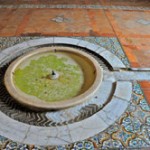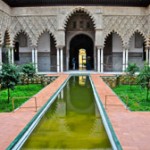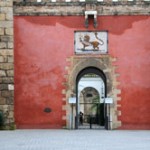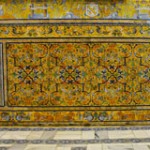- View of the Gardens of Alcazar
- Fountains of Alcazar
- Inside the palace
- The courtyard
- Entrance of Alcazar
- Alcazar wall designs
The Alcazar of Seville is the official residence for the king and queen of Spain. It is built on the foundations of an old Moorish fort and it incorporates elements of both Christian and Islamic architecture, at least that is how it appears to me. Today when the palace is not actually in use as an official residence it is available for tourist viewing. The Alcazar is just across from the Cathedral of Seville and what one sees from the outside is not impressive, just some old medieval walls and a plain entrances, but what awaits the visitor inside is incredible. The site is so unassuming that I almost passed it by, but just to make sure, I ran a google check on my wireless. Thank God I did! This is a good reason to carry a wireless; it gives you the ability to research something on the spot.
Once inside one finds a beautiful courtyard that is a fascinating blend of Islamic and Christian architecture. This was my first exposure to Islamic architecture and I was immediately taken aback. It is beautiful and compelling. Yes, I have seen Islamic architecture in books and movies, but to actually see it in person for the first time is breathtaking. It is absolutely mathematical and symmetrical, and the wall and ceiling designs are enchanting. The use of light colors creates a feeling of lightness and upliftment. I was thoroughly impressed and I would like to see more especially in a modern Islamic country. I would like to see how this develops given a 1000 more years. Spain has only 600 years of Islamic history and I am sure that much of it has been obliterated by time and Christianity. I now want to go to an Islamic country, perhaps Turkey, Egypt or Saudi Arabia, to see how this develops given more time. However, one thing I did notice as I moved from room to room, the whole experience has a tendency to become monotonous and even tedious. What a contradiction! The first impression is one of break-taking beauty, but then it turns to monotony.
I also learned that somewhere under the palace there are rainwater chambers, large cisterns, called the Baths of Lady Maria de Padill. Tourists are unfortunately not allow to see this. I did, however, find a photo of one water chamber. At the rear of the palace are spectacular gardens. Perhaps May or June would be the best time to visit these wonderful gardens.
My visit to Real Alcazar was extremely worth while. It was my first experience with Islam as a culture. Even though I felt the tedium of this kind of architecture, I also experienced its beauty and power. My appetite has been wet. I want to explore more of Andalusia and even Islam. Perhaps my next stop will be to the Alhambra at Granada. I am intrigued by this ancient Moorish world.






